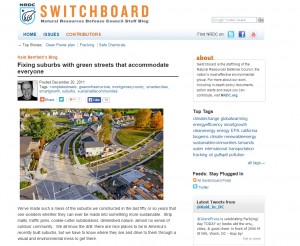We’ve made such a mess of the suburbs we constructed in the last fifty or so years that one wonders whether they can ever be made into something more sustainable. Strip malls, traffic jams, cookie-cutter subdivisions, diminished nature, almost no sense of outdoor community. We all know the drill: there are nice places to be in America’s recently built suburbs, but we have to know where they are and drive to them through a visual and environmental mess to get there.
One of the most challenging aspects of suburbs, and of the prescriptions for improving them, is the character of their roadways. Most of us take the poor design of our streets – the most visible part of most suburban communities, if you think about it – so much for granted that it never occurs to us that they actually could be made better for the community and for the environment. Consider, for example, main “arterial” streets so wide that pedestrians can’t cross them, even if there is a reason to; little if any greenery to absorb water, heat, or provide a calming influence; or residential streets with no sidewalks.
Fixing suburbs with green streets that accommodate everyone
